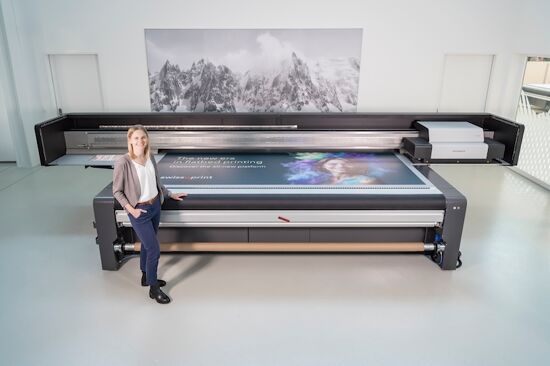Branch Technology makes history with 3D-printed building project

The Tennessee-based construction-tech company Branch Technology applied its experience in architectural facades and 3D-printing robots to complete the first freeform 3D-printed composite project in the world.
Developed for Tennessee Valley Federal Credit Union (TVFCU), Branch collaborated with the architecture firm and general contractor to create a glass fibre reinforced concrete (GFRC) facade. This is the first commercial building with a 3D-printed building envelope in the US.
Branch's 3D-print technology has been developed specifically for use in the construction sector, offering what the company said is a more sustainable and cost-effective method for producing construction-scale components.
Speaking to FESPA.com, John McCabe, director of brand and communications at Branch, said that 38% of landfill waste is shipped directly from construction sites worldwide. Using Branch’s unique technology, he said, will allow architects and developers to reduce production waste while unlocking design freedom for their projects.
“Our desire is to change the built world, create a more sustainable future, and establish a more resilient supply chain for construction,” McCabe told FESPA.com. “With Branch, we only use material where it is needed.
“Many companies are interested in purchasing robots and doing the work themselves onsite, but this is a more expensive proposition than they fully understand. The value of prefabricated modules is that you don't have to deal with factors such as the weather and vandalism.
“We do all the production in our advanced design and manufacturing centre ourselves and currently don't sell our technology.”
By manufacturing all of the building parts at its facility, McCabe said it can meet project deadlines and ship these out to customers worldwide and assist with fitting the pieces together onsite “like Lego”.
Returning to the TVFCU project, McCabe said this collaboration was a “beautiful accident,”, explaining that the Credit Union was where Branch's founder received some of the initial capital to launch the business.
The TVFC building has minimal employees working locally and instead relies on technology, allowing customers to engage with tellers offsite. To reflect this mindset, McCabe said the aim for Credit Union was for the exterior of the building to reflect the same innovation that exists the inside.
“Internally, we provided many incredibly designed facade options to the client and landed on one that reflected the companies brand and the regional beauty of Tennessee,” McCabe said.
“The project elevated everyone who was involved and has proved to be a huge game-changer for commercial construction.”
Discover the latest innovations in 3D printing at the Global Print Expo 2021, Europe's leading exhibition for screen and digital wide format print, textile printing and signage. Discover the latest products, network with like-minded individuals and explore new business opportunites. Register now and use promo code FESH101 to receive a discount of 30 euros.
Topics
Interested in joining our community?
Enquire today about joining your local FESPA Association or FESPA Direct
Recent news

The importance of ink for large format printers
Ink is crucial for large format inkjet printers, influencing substrate compatibility, productivity, and cost. Nessan Cleary discusses the three main types which include UV-curable ink, latex ink and eco-solvent ink. Each ink type has specific strengths and weaknesses, making printers choice dependent on budget and intended applications.

What are the benefits of Direct-To-Fabric printing?
Direct-to-fabric printing is gaining popularity for high-volume textile production, enabling on-demand, customized short runs. These printers offer ink flexibility, accommodating various fabric types like cotton and silk, though ink development focuses on faster turnaround by reducing pre- and post-processing. Compared to traditional methods, direct-to-fabric inkjet printing is a more sustainable option due to reduced water and chemical usage, and localized production.

What are the opportunities for large format providers regarding digital touch screens?
Digital touchscreens are becoming increasingly common, offering businesses opportunities to improve customer engagement and streamline operations. Nessan Cleary shares, while more expensive to implement than standard digital displays due to complex software and integration needs, touchscreens provide self-service options, multilingual support, and can reduce staffing costs in various settings like retail, transportation, and healthcare.
